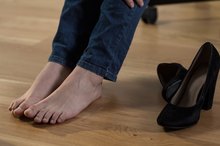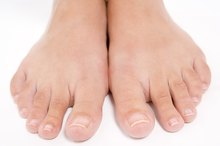How to Lower Water Weight in Legs & Feet
When you retain fluid, the fluid often accumulates in the most dependent part of your body, your legs and feet. Retaining fluid in the legs and feet -- a condition known as dependent edema -- can make it uncomfortable to walk and difficult to put shoes on. Swelling often increases when it's hot outside, which in certain parts of Arizona can mean most of the year. Simple measures can help reduce swelling. Getting treatment for underlying medical conditions that cause fluid retention can also help. See your doctor if you're retaining fluid in your lower extremities.
Causes
Determining the cause of fluid retention in the legs can help you and your doctor devise the proper treatment. Excess sodium intake and vein problems such as varicose veins or blood clots in your legs can cause swelling in your feet and legs. Since fluid flows to the lowest point, excess water will end up in your legs and feet. If you have a heart condition that makes your heart pump less effectively than normal, fluid will back up in your circulatory system, often causing lower extremity swelling. Increased blood volume during pregnancy often causes dependent edema. Simply standing for long periods of time in hot weather can also cause legs and feet to swell. Diabetes and kidney disease can also increase dependent edema.
Simple Measures
How to Lower Water Weight in Legs & Feet
Learn More
One of the simplest ways to reduce dependent edema is to elevate your legs and feet higher than your heart. This encourages the flow of fluid back to the heart. In hot weather, cooling your feet and legs in a cool bath or pail of water can also help reduce edema, since the cold constricts blood vessels so that less fluid accumulates in them. Elevate your legs whenever you sit down during the day. When sitting for long periods, such as on long car or plane trips, move your legs frequently and don't sit with your legs or ankles crossed.
Dietary Measures
Although it might seem counterintuitive, drinking more water helps your kidneys flush out excess fluid. Reduce sodium intake to no more than 1,500 milligrams per day, if possible; this is the amount recommended by the American Heart Association. If you can't get your intake that low, aim for 2,300 milligrams per day, the amount recommended by the 2010 Dietary Guidelines for Americans. Supplements such as B-5, B-6, calcium or some herbs might help reduce edema, but don't take supplements without your doctor's approval.
Clothing Choices
What Are the Treatments for Edema in Leg?
Learn More
Avoid shoes and socks that fit tightly, cutting off circulation to your lower legs or feet. Ask your doctor if compression stockings would help reduce your fluid retention. Compression stockings fit more tightly near your feet and become looser closer to your thigh. Put them on before you even get out of bed in the morning. The fit prevents blood from pooling in the legs. Compression stockings come in different strengths; talk to your doctor about the type appropriate for your condition. Some compressions stockings are sold only by prescription.
Medications
Your doctor might prescribe diuretics in some cases to reduce fluid volume and decrease dependent edema. Never take diuretics without your doctor's permission, since they have side effects. Drugs that strengthen your heart and increase the force of each heartbeat can also improve blood pooling in the lower legs and feet. Medications to treat underlying diseases such as diabetes and kidney disease will decrease complications such as lower limb edema.
Related Articles
References
- University of Maryland Medical Center: Edema
- Medical News Tonight: What Is Water Retention (Fluid Retention)? What Causes Water Retention?
- Better Health Channel: Fluid Retention
- American Heart Association: Sodium (Salt or Sodium Chloride)
- MayoClinic.com: How to Tame Your Salt Habit Now
- University of Missouri System: Chronic Venous Insufficiency
Writer Bio
This article was written by the CareerTrend team, copy edited and fact checked through a multi-point auditing system, in efforts to ensure our readers only receive the best information. To submit your questions or ideas, or to simply learn more about CareerTrend, contact us [here](http://careertrend.com/about-us).









